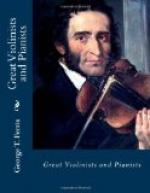The Genealogy of the Piano-forte.—The Harpsichord its Immediate Predecessor.—Supposed Invention of the Piano-forte.—Silbermann the First Maker.—Anecdote of Frederick the Great.—The Piano-forte only slowly makes its Way as against the Clavichord and Harpsichord.—Emanuel Bach, the First Composer of Sonatas for the Piano-forte.—His Views of playing on the New Instrument.—Haydn and Mozart as Players.—Muzio Clementi, the Earliest Virtuoso, strictly speaking, as a Pianist.—Born in Rome in 1752.—Scion of an Artistic Family.—First Musical Training.—Rapid Development of his Talents.—Composes Contrapuntal Works at the Age of Fourteen.—Early Studies of the Organ and Harpsichord.—Goes to England to complete his Studies.—Creates an Unequaled Furore in London.—John Christian Bach’s Opinion of Clementi.—Clementi’s Musical Tour.—His Duel with Mozart before the Emperor.—Tenor of Clementi’s Life in England.—Clementi’s Pupils.—Trip to St. Petersburg.—Sphor’s Anecdote of Him.—Mercantile and Manufacturing Interest in the Piano as Partner of Collard.—The Players and Composers trained under Clementi.—His Composition.—Status as a Player.—Character and Influence as an Artist.—Development of the Technique of the Piano, culminating in Clementi.
I.
Before touching the life of Clementi, the first of the great virtuosos who may be considered distinctively composers for and players on the pianoforte, it is indispensable to a clear understanding of the theme involved that the reader should turn back for a brief glance at the history of the piano and piano-playing prior to his time. Before the piano-forte came the harpsichord, prior to the latter the spinet, then the virginal, the clavichord, and monochord; before these, the clavieytherium. Before these instruments, which bring us down to modern civilized times, and constitute the genealogy of the piano-forte, we have the dulcimer and psaltery, and all the Egyptian, Grecian, and Roman harps and lyres which were struck with a quill or plectrum. No product of human ingenuity has been the outcome of a steady and systematic growth from age to age by more demonstrable stages than this most remarkable of musical instruments. As it is not the intention to offer an essay on the piano, but only to make clearer the conditions under which a great school of players began to appear, the antiquities of the topic are not necessary to be touched.
The modern piano-forte had as its immediate predecessor the harpsichord, the instrument on which the heroines of the novels of Fielding, Smollett, Richardson, and their contemporaries were wont to discourse sweet music, and for which Haydn and Mozart composed some delightful minor works. In the harpsichord the strings were set in vibration by points of quill or hard leather. One of these instruments looked like a piano, only it was provided with two keyboards, one above the other, related to each other as the




